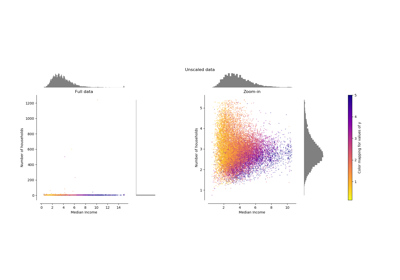sklearn.preprocessing.minmax_scale¶
-
sklearn.preprocessing.minmax_scale(X, feature_range=(0, 1), axis=0, copy=True)[source]¶ Transforms features by scaling each feature to a given range.
This estimator scales and translates each feature individually such that it is in the given range on the training set, i.e. between zero and one.
The transformation is given by (when
axis=0):X_std = (X - X.min(axis=0)) / (X.max(axis=0) - X.min(axis=0)) X_scaled = X_std * (max - min) + min
where min, max = feature_range.
The transformation is calculated as (when
axis=0):X_scaled = scale * X + min - X.min(axis=0) * scale where scale = (max - min) / (X.max(axis=0) - X.min(axis=0))
This transformation is often used as an alternative to zero mean, unit variance scaling.
Read more in the User Guide.
New in version 0.17: minmax_scale function interface to
sklearn.preprocessing.MinMaxScaler.Parameters: - X : array-like, shape (n_samples, n_features)
The data.
- feature_range : tuple (min, max), default=(0, 1)
Desired range of transformed data.
- axis : int (0 by default)
axis used to scale along. If 0, independently scale each feature, otherwise (if 1) scale each sample.
- copy : boolean, optional, default is True
Set to False to perform inplace scaling and avoid a copy (if the input is already a numpy array).
See also
MinMaxScaler- Performs scaling to a given range using the``Transformer`` API (e.g. as part of a preprocessing
sklearn.pipeline.Pipeline).
Notes
For a comparison of the different scalers, transformers, and normalizers, see examples/preprocessing/plot_all_scaling.py.


